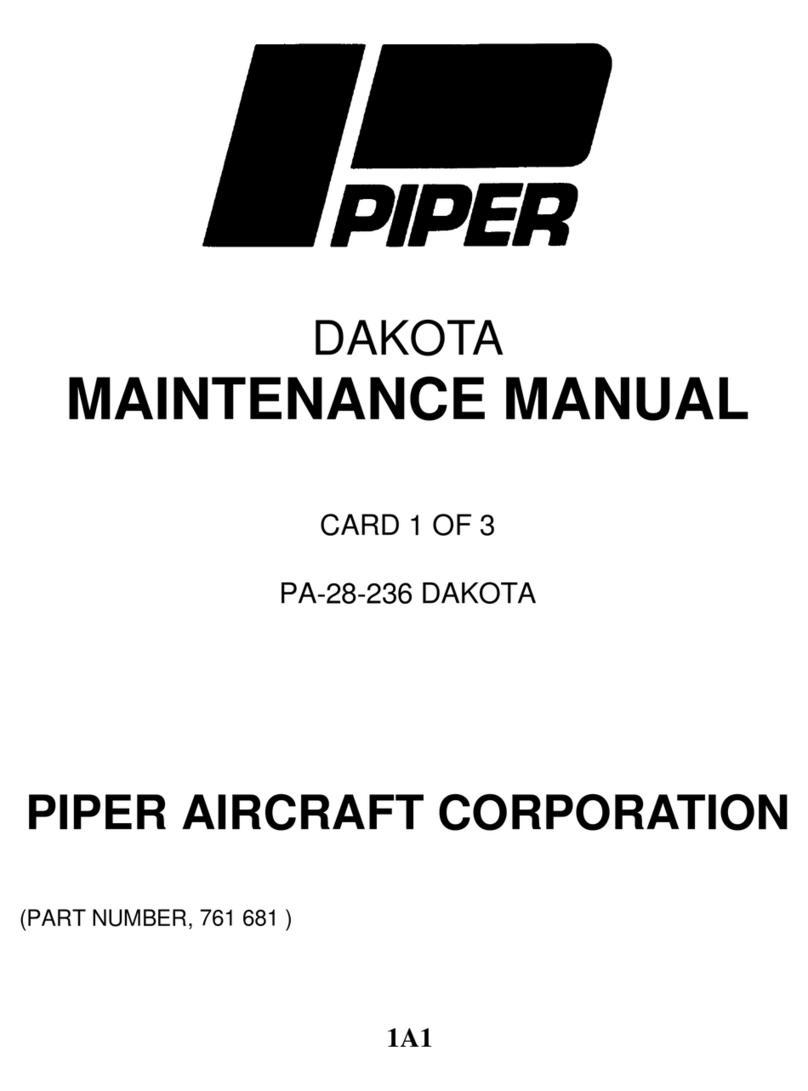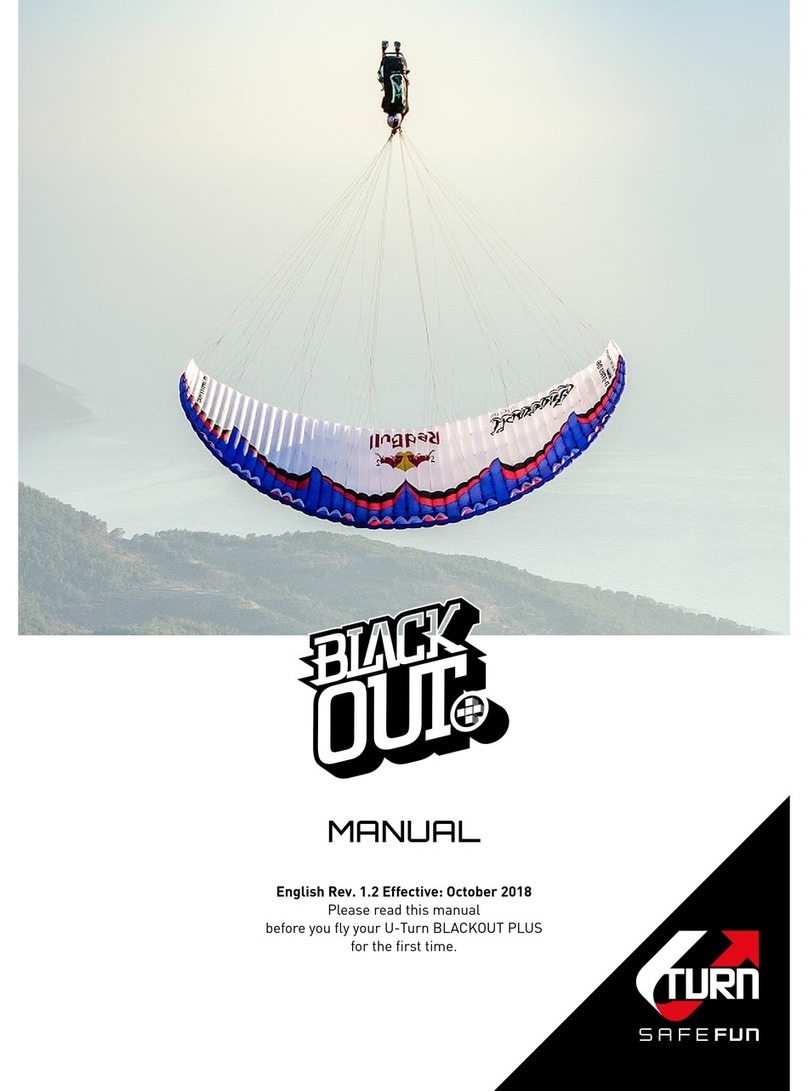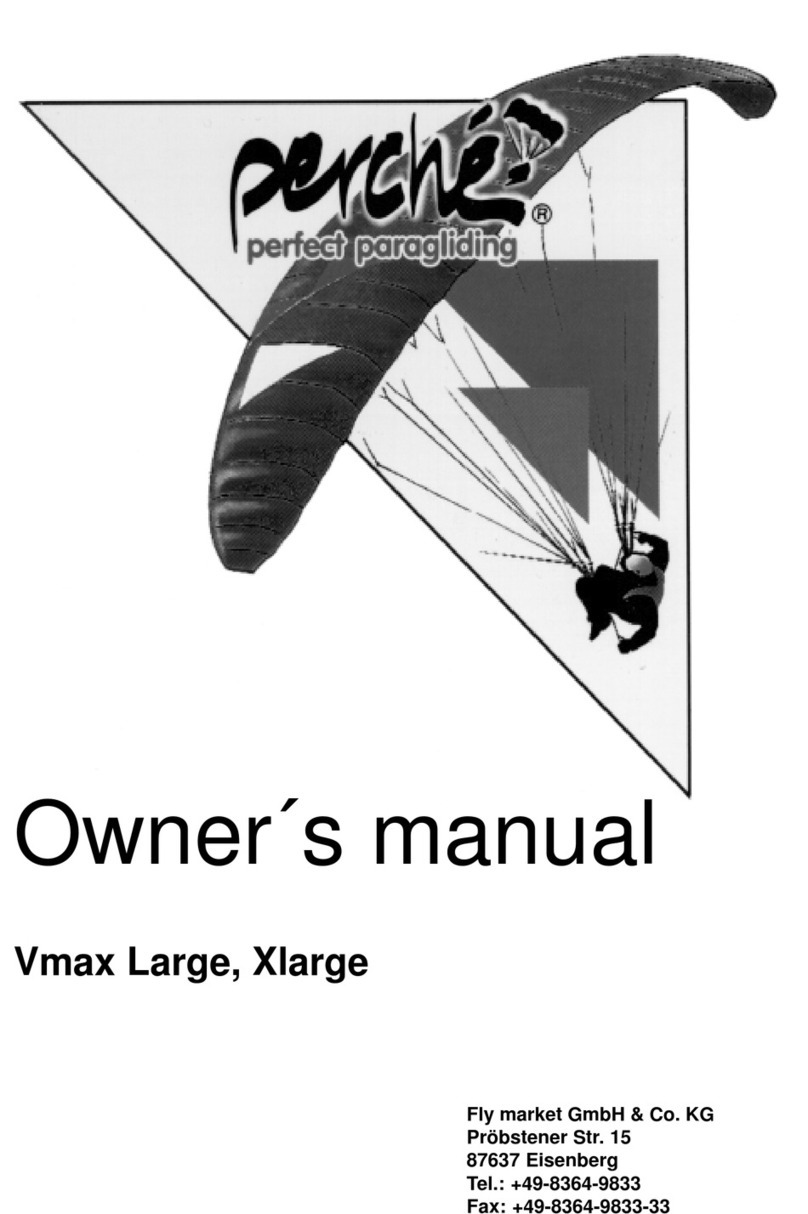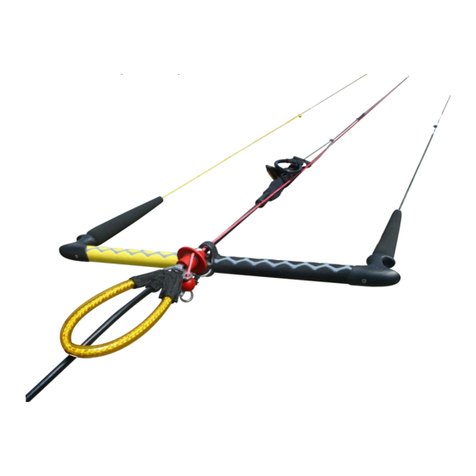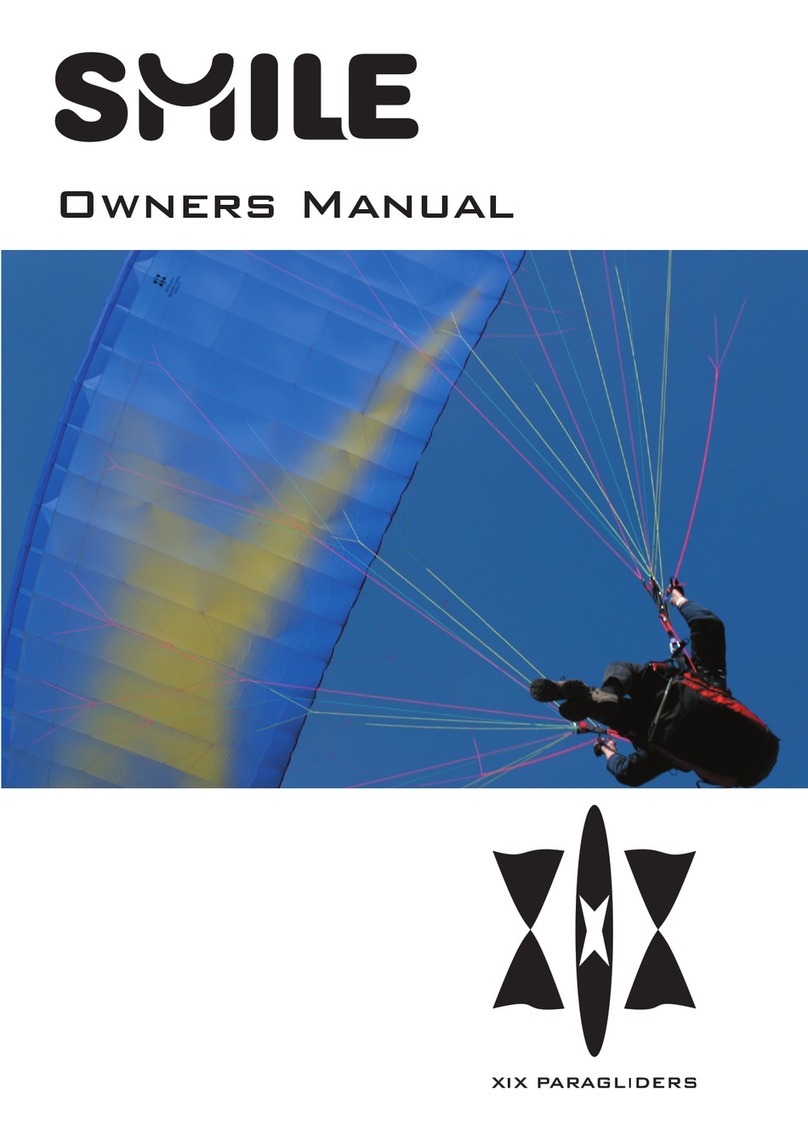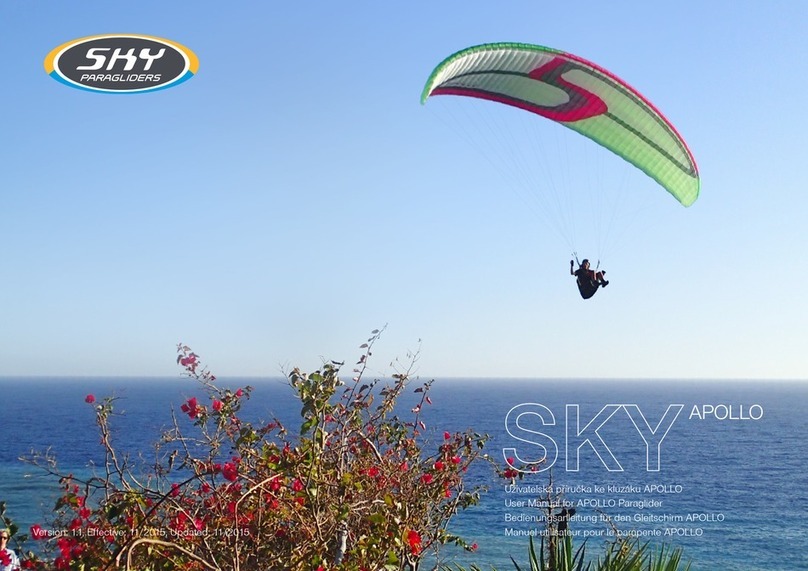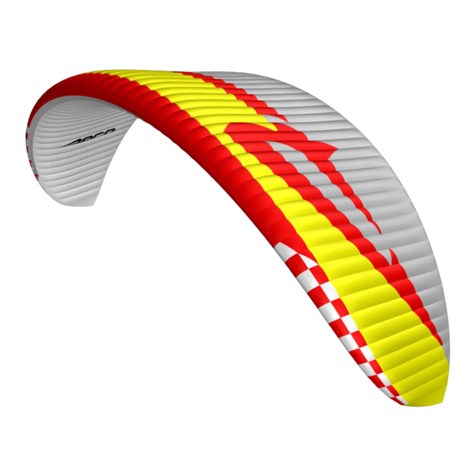Gin Gliders Gingo User manual

Gingo Owner’s Manual
Please read this manual before flying with the Gingo for the first time.

2
Thank You…
Thank you for choosing the Gingo harness. We are confident that this harness will provide you
with enhanced comfort, control, performance and fun in flight. This manual contains all the
information you need to set up, trim, fly and maintain your harness. A thorough knowledge of
yourequipmentwillkeepyousafeandenableyoutomaximizeyourfullpotential.
Pleasepassonthismanualtothenewownerifyoudoresellyourharness.
HappyFlightsandSafeLandings,
TheGINTeam
Safety Notice
By the purchase of our equipment, you are responsible for being a certified paraglider
pilot and you accept all risks inherent with paragliding activities including injury and
death. Improper use or misuse of GIN equipment greatly increases these risks.
Neither Gin Gliders Inc nor the seller of GIN equipment shall be held liable for
personal or third party injuries or damages under any circumstances. If any aspect of
the use of our equipment remains unclear, please contact your local GIN reseller or
importer in your country.

3
Contents
Thank You…..........................................................................................................................2
1. Gin Gliders ........................................................................................................................4
2. Introducing the Gingo.......................................................................................................5
FeaturesofGingo.....................................................................................................................................6
OptionalExtras........................................................................................................................................6
Backprotection..................................................................................................................................6
Lateral protection..............................................................................................................................7
Rescue parachute...............................................................................................................................7
Speedbar...........................................................................................................................................8
FlightDeck.........................................................................................................................................8
OtherAccessories..............................................................................................................................8
3. Before you fly...................................................................................................................9
Assembly .................................................................................................................................................9
Speedsystem.....................................................................................................................................9
Backand Lateral Protection...............................................................................................................9
Rescue Installation..........................................................................................................................10
Adjustments...........................................................................................................................................13
Shoulderstraps................................................................................................................................13
Lateral straps ..................................................................................................................................13
Legstraps........................................................................................................................................13
Sidestraps to seatplate..................................................................................................................13
Cheststrap.......................................................................................................................................13
Speedbar.........................................................................................................................................14
4. Flying with the Gingo ......................................................................................................15
Pre-flightchecks....................................................................................................................................15
Rescue Deployment................................................................................................................................15
Storage/Pockets.....................................................................................................................................16
Landingwith the Gingo..........................................................................................................................16
5. Miscellaneous..................................................................................................................17
Towing...................................................................................................................................................17
Tandemflying........................................................................................................................................17
Flyingover water...................................................................................................................................17
6. Care, Maintenance and Repairs........................................................................................17
Careand Maintenance ............................................................................................................................17
Inspectionchecklist.........................................................................................................................18
Repairs...................................................................................................................................................18
7. Technical Data.................................................................................................................19
Specification .........................................................................................................................................19
Certification...........................................................................................................................................19
Gingoharness..................................................................................................................................19
GINSOFTII back protection...............................................................................................................19
Description ............................................................................................................................................20

4
1. Gin Gliders
Gin Gliders was formed in 1998 by paraglider designer and competition pilot Gin Seok Song and
histeamofengineers and test pilots.
Gin’s philosophy is simple: to design paragliding equipment that he and any other pilot love to
fly. This philosophy applies equally for a harness such as the Gingo, as for the world-beating
competition glider, the Boomerang. No product is released to the market without Gin’s complete
satisfaction. GIN Gliders produce a complete range of accessories and can provide you with
many useful items for flying which are all manufactured in GIN Gliders own production facility
toguaranteehighestquality standards.
Gin has over 15 years’ experience of designing and manufacturing paragliders and is backed up
by an equally experienced team, both within the company in Korea and throughout a worldwide
network of distributors and dealers. The “GIN Team” has won the Paragliding World Cup overall
several times and has had countless other competition successes in World Cups, World and
National Championships. This high level of expertise provided by dedicated professionals
ensuresthatyouget the best possible product support and after sales service.

5
2. Introducing the Gingo
The Gingo was developed by the R&D team of Gin Gliders to meet the highest standards of the
most demanding pilots - the Gingo is the harness used by GIN test pilots during the
development of new paragliders. The Gingo is suitable for a wide range of pilots, for the
beginneraswellas for the occasional club pilot or even the dedicated cross country pilot.
The Gingo can be flown with all types of paragliders unless the manufacturer of your paraglider
requires a specific harness to be used with his paraglider. Please refer to the manual of your
paraglider to find out if this might be the case. The Gingo is a sleek and easy harness, designed
for maximum comfort and ease of use. The elegant design focuses on simplicity, eliminating the
needforcomplicatedadjustments.
The overall geometry of the harness enables the pilot to feel the feedback from the glider
sensitively, whilst retaining a secure feeling in flight. This increases the precision of turns
while thermaling and aids active flying. On long flights, the comfort of the Gingo is second to
none.
Leg and chest straps are equipped with the “T-lock safety system” to prevent the pilot from
fallingoutofthe harness if he forgets to fasten the leg straps.

6
The safety has also been improved by optimising the position of the back protection; the rear
pockethasbeen movedupwards, offering protection for the pilot in case he accidentallyfalls on
hisback.
The bottom rescue container is designed to enable a fast and easy deployment of the parachute.
The bottom position is ideal because the weight of the rescue stays near the centre of gravity
andthereforeprovidesyou with the most balanced comfort and feeling in flight.
The new elastic speed bar retainer prevents the bridle of your rescue becoming entangled in
caseofarescue deployment.
Features of the Gingo:
Rescueattachmentbridle
Carabiners
Optionalbackandlateral protection
Largedorsalstoragepocket and numerous small pockets for long flights
TheGingoisDHV certified and available in sizes S, M and L.
Weight:4.4Kg(M size without back protection).
Weightofbackprotection GINSOFT II: 0,9 Kg.
Optional Extras
Thefollowingitemsare available as optional extras.
Backprotection
The Gingo is equipped with an optional GINSOFT II soft back protector with 17 cm thickness. A
hard foam layer to protect the GINSOFT II against punctures is integrated into the Gingo
harness. The back protector is divided into separate compartments, to prevent air being
dissipatedtoorapidlyin the event of a hard impact.
The GINSOFT II is designed to protect the pilot in case of an impact and to reduce the energy of
the impact as much as possible, but it cannot completely eliminate the risk of injury. The

7
GINSOFTII back protection is DHV certified and free compatible, whichmeansit can be used with
anyharnesswitha large enough container for the back protection.
TheGINSOFTIIprotector is the lightest soft foam protector with DHV certification.
Lateralprotection
You can add lateral protection to the Gingo, as well as back protection, by fitting a pair of Gin
sideimpactplates.
Rescueparachute
The Gingo is designed for use with GIN rescue parachutes, like the ONE G. Other manufacturers’
rescue systems may also be used. Every first installation of a rescue system into the harness
(that means every new combination of harness and rescue system) must be checked by a
qualified paragliding professional. This is called a "compatibility check". In this compatibility
check the pilot himself, who will be flying with this harness, must always sit in the harness
hanging from a simulator and deploy the rescue from the harness container. This check must
alsobedoneeach time after the rescue has been repacked and re-installed.

8
Speedbar
The Gingo is compatible with all common types of speed systems. We recommend the GIN
aluminiumspeedbar.
FlightDeck
The Gingo may be fitted with a flight deck, allowing easier viewing of instruments and/or
carryingofballast.
OtherAccessories
For up-to-date information on additional accessories, visit www.gingliders.com or contact your
localGINdealeror the distributor in your country.

9
3. Before you fly
The Gingo must be assembled by a suitably qualified paragliding professional, for example your
instructor. In particular great care and attention must be paid to the fitting of the rescue
parachuteintheharness. The pilot should then adjust the harness for comfort.
Assembly
Gin Gliders recommend that assembly be carried out in the order below. If there is any doubt
whatsoever about this procedure, please seek professional advice from your instructor, GIN
dealerorimporter.
Speedsystem
The speed system is assembled from top to bottom. Pass the cord of the speed bar through the
pair of pulleys near the sidepocket and route it out through the eyelet near the front corners at
each side of the seat. Attach the elastic cord to the speed bar to prevent tangling in case of a
parachutedeployment.
Backand LateralProtection
When you receive the GINSOFT II it is rolled. Please let it lay open for several hours before you
install it in the harness. To install it, open the zipper inside the back pocket and slide the
GINSOFT II back protection inside. It needs to slide into the space underneath the seat plate and
behind the back support. Do not put it underneath the cross straps in the back of the harness.
The protection should be not compressed in normal use and should not hamper the space of the
rescueormoveinto an incorrect position.
You can add lateral protection to the Gingo, by fitting a pair of Gin side impact plates into the
harnesseithersideof the back protector and securing them with the Velcro straps.

10
RescueInstallation
The Gingo is compatible with GIN rescue parachutes. Other manufacturer’s rescues may be used
aswell,butas already mentioned earlier in this manual:
Every first installation of a rescue system into the harness, (that means every new combination
of harness and rescue system) must be checked by a qualified paragliding professional. Prior to
the installation, you should also ensure that you have the necessary materials to complete the
procedure,forexample,suitable maillons and thread.
Rescue parachutes should be repacked at least every 6 months, so installing your rescue in a
new harness may also provide a good opportunity for a repack. Check your rescue manual for
furtherdetails.
To attach the rescue bridle to the harness webbing
A Maillon Rapide type carabiner is recommended. The carabiner should be rated at least 9 times
themaximumweight,for example, a 6mm stainless CEN certified carabiner – 2785 Kg.
The Maillon should be held in place with rubber bands, tape or plastic heat shrink tube. Webbing
to webbing connections are not recommended, due to the danger of getting the knot the wrong
wayround,whichsignificantly weakens the connection.
Attaching rescue deployment bag to the harness deployment handle
The rescue container of the Gingo comes with its own deployment handle. This handle and its
strap must be connected to the deployment bag of the parachute. Connect it with the loop at the
side of the deployment bag when installing it into the Gingo. If your parachute’s deployment
bag does not have the proper loop, please contact your parachute dealer or a qualified
professional to attach the deployment handle by sewing or to add a new loop in the correct
positiononthedeployment bag.

11
In any case a qualified professional must check the compatibility of the system; harness and
rescue parachute, when a rescue parachute is installed for the first time. After every repack of
the rescue parachute you can do this compatibility check yourself. Please observe carefully how
the professional installs the rescue system, so that you can remember the procedure when you
have to do it yourself the next time. This compatibility check - that means to test if the rescue
can be released from the rescue container in the harness - must be done by the pilot himself,
sitting in the harness hanging from a simulator. It must be done after every repack of the
rescue parachute to be sure that the rescue can be released without problems in case of an
emergency.

12
Rescue Installation guide
Takespecialcare:The deployment handle must be attached to the side loop on the deployment
bag,nottothe centre loop.

13
Adjustments
The Gingo should be adjusted to suit your physique and flying style. It is important to adjust it
correctlytoensureyou can easily slide into the sitting position after take off.
Adjustments should ideally be tested by hanging in a simulator prior to the first flight.
Additionalfinetuningcan be done during your first few flights.
Ensure that the rescue system, back and side protection have been installed before making
adjustments.
Shoulderstraps
The optimum setting for the shoulder straps depends on the height of the pilot. Stand upright
with the chest/leg straps closed and symmetrically adjust the shoulder straps until they are
justtight.Duringflight, these straps should be a little slack.
Lateralstraps
The lateral straps adjust the angle between the thighs and the back. This angle can be set
between 70° and 90°. Lengthening the straps increases the angle and vice-versa. The easiest
way to adjust them correctly is during a flight in calm air. Remember that flying in the “supine
position”, that means leaning back, reduces the stability of the harness and increases the risk
oftwistingafteran asymmetric deflation.
Legstraps
The correct adjustment of the leg straps is to have them a little loose to enable an easy slide
intothesittingposition after takeoff.
Sidestraps toseat plate
These straps help you to adjust the angle of the seat plate and give support for your legs on
long flights. They also allow you to feel more feedback from the glider by feeling the gliders
movementswithyourhip.
Cheststrap
The adjustment of the chest strap controls the distance between the carabiners and affects the
handling and stability of the glider. Widening the distance between the carabiners increases
feedback from the wing and allows for easier weight shifting. Closing the strap gives you a
more stable feeling in turbulence but increases the risk of stable spiral and also the risk of
twisting!
We advise pilots of GIN paragliders to fly with a distance between the carabiners of
approximately44to48 cm.
The chest strap may also be adjusted in flight according to the conditions; for example, it may
betightenedinturbulent air and flown at a looser setting in weak conditions.

14
Speedbar
Hanging in the simulator, adjust the length of the speed bar cord so that the bar hangs at least
15cm below the front of the harness. Making the cord too short could result in the speed system
being constantly and unintentionally engaged during flight. It is safer to start with the speed
bar a little long andshorten it following your first flights. Testthe speed bar in flight onlyafter
you are comfortable with your new harness, and always do so in calm conditions with ample
clearanceabovetheground.

15
4. Flying with the Gingo
Pre-flight checks
Formaximumsafety,use a complete and consistent system of pre-flight checks and repeat the
samementalsequence
every
flight.
Checkthat:
Thereisnovisible damage to the harness or carabiners that could affect its airworthiness.
Therescueparachutecontainer is closed correctly and the pins are in the right position.
Thedeploymenthandleis completely inserted into the elastic pockets.
All buckles, belts, zips are securely fastened. Buckles should click into place as you close
them, and a gentle pull on the fastened buckle verifies this. Secure any zips
after
fasteningthebuckles.Take extra care in snowy or sandy environments.
The paraglider is connected correctly to the harness and both carabiners are secured by
theirlockingmechanisms.
Thespeedbaris attached correctly to glider.
Allpocketsareclosed properly and any loose items are tied down safely.
Checkagainthatyou have closed your leg and chest straps before you take off!
Rescue Deployment
It is vital to periodically feel the position of the rescue handle in normal flight, so that the
actionofreachingfor the rescue handle is instinctive in an emergency.
In the event of an emergency, the pilot must quickly evaluate his or her height and the
seriousness of the incident. Deploying the rescue when the glider is recoverable may increase
the danger of injury. If you have sufficient height and the glider is in a flat spin, it is preferable
to first try to stop the spin(e.g. full stall), due to the risk of entanglement. On the other hand, a
second’shesitationindeploying the reserve could prove costly if there is insufficient height.

16
Iftherescueis to be deployed, the procedure is as follows:
Lookfortherescue handle and grasp it firmly with one hand
Pull sidewards / upwards on the handle to release the deployment bag from the harness
container
Look for a clear area, and in a continuous motion, throw (and RELEASE!) the rescue away
from yourself and the glider, preferably into the air stream and against the direction
ofspin
After deployment, avoid entanglement and pendulum motions by pulling in the glider as
symmetricallyaspossiblewith the B, C, D or brake lines
On landing take an upright body position and be sure to do a PLF (Parachute Landing Fall)
tominimizetherisk of injury
Storage/Pockets
The Gingo contains a large back pocket and smaller side pockets. They are positioned to prevent
contents from falling out during flight if the pocket is opened. There is also a radio
compartment inside the back pocket and a hole to pass the cable through for a handheld
speaker-microphoneoraCamel Bak.
Landing with the Gingo
Before landing, slide your legs forward in the harness so that you adopt the standing position.
NEVER land in the seated position; it is very dangerous for your back even if you have back
protection. Standing up before landing is an active safety system, and is much more effective
thanthepassivesystem of back protection.

17
5. Miscellaneous
Towing
The Gingo is also excellent for towing. The tow release can be connected to the main carabiners
or to the towing loops. The best position to attach a tow release is to use a towing adapter,
which slides over the lower ends of the risers of the paraglider. For further details refer to the
documentation provided with your tow release or towing adaptor or ask a qualified towing
instructoratyourtow site.
Tandem flying
TheGingoisnot recommended for tandem flying.
Flying over water
The back protection should be removed during extreme manoeuvres training and all other
flightsoverwater,due to the increased possibility of drowning after a water landing.
6. Care, Maintenance and Repairs
The materials used in the Gingo have been carefully selected for maximum durability.
Nevertheless, keeping your harness clean and airworthy will ensure a long period of continuous
safeoperation.
Care and Maintenance
Avoiddraggingyourharness over rough or rocky ground.
UnnecessaryexposuretoUV rays, heat and humidity should be always avoided.
Keeptheharnessin your rucksack when not in use.
Storeallyourparagliding equipment in a cool, dry place, and never put it away while damp
orwet.
Keepyourharnessas clean as possible by regularly cleaning off dirt with a plastic bristled
brushand/oradamp cloth. If the harness gets exceptionally dirty, wash it with water
andamildsoap. Make sure you first remove all the sub-components: seat board, back
plate,backprotection,rescue parachute etc. Allow the harness to dry naturally in a
wellventilatedareaaway from direct sunlight.
Ifyourrescueparachute ever gets wet (e.g. in a water landing) you must remove it from
theharness,dryit and repack it before putting it back in the container.
Afterahardlanding you must check your back protection for damage. A tear in the GINSOFT
IIcouldsignificantlyreduce the efficiency of the protection it provides.
Thezipsandbuckles may be occasionally lubricated with silicone spray, no more than once
ayear.

18
Inspectionchecklist
In addition to regular pre-flight checks, the Gingo should be inspected thoroughly on every
rescue repack, normally every 6 months. Additional inspections should be performed after any
crash, bad landing or take off, or if there are any signs of damage or undue wear. Always seek
professionaladvicewheneverin doubt. The following checks should be carried out:
Check all webbing, straps and buckles for wear and damage, especially the areas that are
noteasilyseen,such as the inside of the carabiner hook-in points.
All sewing must be intact and any anomalies attended to immediately to avoid
exacerbationoftheproblem.
Special attention should be paid to the rescue installation, particularly the elastic and
Velcroparts.
Theseatandback plates must be free from cracks.
The main aluminium carabiners must be replaced
at least
every 5 years or after 500 hours,
whatever comes first. Impacts may create undetectable cracks that could result in
structuralfailureundercontinuous load.
Repairs
The manufacturer or an approved specialist should carry out any repair that involves critical
partsoftheharness. This will ensure that the correct materials and repair techniques are used.

19
7. Technical Data
Specification
Description Paraglidingharness
DHV-certifiedmax.load 100Kg
Heightofmainattachment points
aboveseatplate 38cm
CarabinerDistance 38-54cm
Weight(withoutparachute) 4.4Kg (for size M)
ParachuteContainer Integratedcontainerunderneaththe seat plate
Options BackprotectionGINSOFTII, side protection, flight
deck...
Certification
Gingoharness
DHV-GütesiegelNr.GS...
GINSOFTII backprotection
DHV-GütesiegelNr.GSP-0022-95certified 17,5G

20
DESCRIPTION
FABRICOF HARNESS
1-1). OUTSIDE
FABRICCODE 600DKODRAPU 60”
NAME DongJininternationalCorp.
SUPPLIER ADDRESS 950-11Daechi-Dong,Kangnam-Gu,
Seoul-City,Korea
MATERIAL 100%NYLON F.YARN WOVEN FABRIC
(OXFORDSHUTTLELESSLOOM)
FINISHED P/D&W/R& W/P
YARNW’T 320GR/YD
FINISHINGMATERIALW’T 30GR/YD
TOTALW’T 350GR/YD
1-2). INSIDE
FABRICCODE 420DHDN/OXFORD PU 60”
NAME DongJininternationalCorp.
SUPPLIER ADDRESS 950-11Daechi-Dong,Kangnam-Gu,
Seoul-City,Korea
MATERIAL 100%NYLON F.YARN WOVEN FABRIC
(OXFORDSHUTTLELESSLOOM)
FINISHED P/D&W/R& W/P
YARNW’T 290GR/YD
FINISHINGMATERIALW’T 30GR/YD
TOTALW’T 320GR/YD
Table of contents
Other Gin Gliders Aircraft manuals

Gin Gliders
Gin Gliders Explorer2 Dyneema Riser Administrator Guide
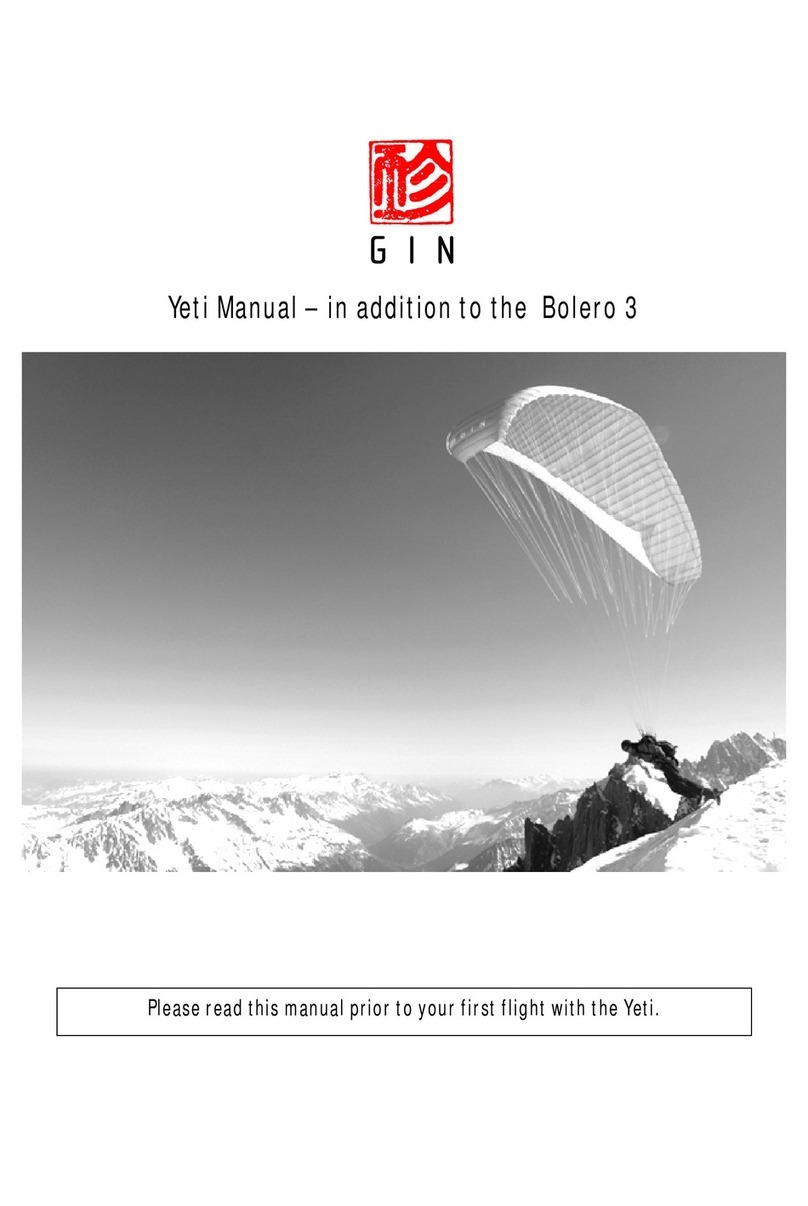
Gin Gliders
Gin Gliders Yeti 08 User manual

Gin Gliders
Gin Gliders PEGASUS User manual
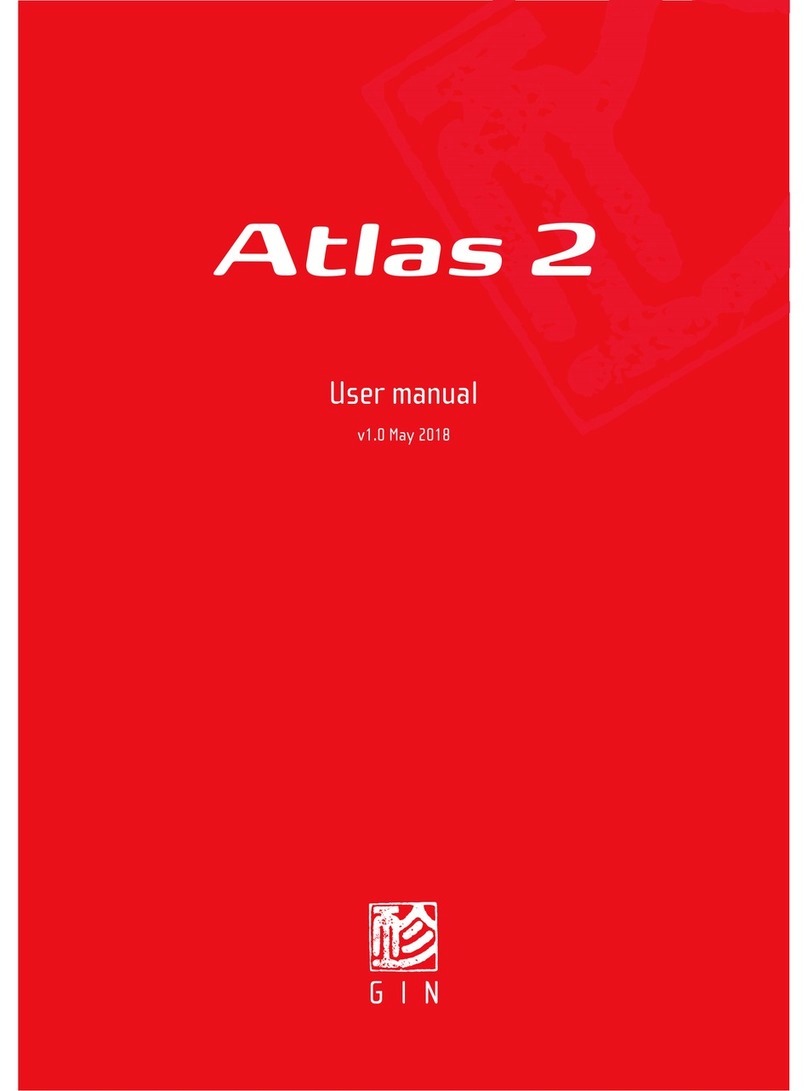
Gin Gliders
Gin Gliders Atlas 2 User manual

Gin Gliders
Gin Gliders Bolero 6 XXS User manual

Gin Gliders
Gin Gliders Safari Passenger User manual
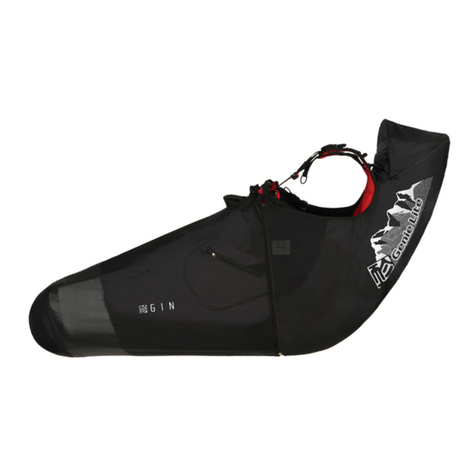
Gin Gliders
Gin Gliders Genie Lite 2 Series Manual

